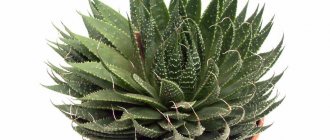- November 19, 2018
- Trees and shrubs
- Legina Marina
Indoor bamboo is an elegant, original plant that most gardeners like. However, it has practically nothing in common with its wild-growing counterpart. Their differences are visible to the naked eye. The wild one is a grass, but despite this, it reaches enormous sizes. At home we grow a miniature tree that belongs to the genus Dracaena. If you are interested in this plant, then let's discuss how to propagate bamboo.
General information
This is an original indoor decoration with a bare stem, at the top of which there are branches with leaves. The trunk can be either straight or curved. Due to this, you can create fancy compositions. Most often, the domestic variety has a green tint. But there are some species with golden foliage and stems.
Since propagating bamboo is not particularly difficult, it is enough to find the mother plant from someone you know. If you adhere to the philosophy of Feng Shui, then young bamboo should definitely appear in your home. It will not only bring prosperity, but also diversify your flower collection.
Where are you from?
The plant belongs to the Dracaena family and is called Dracaena Sander in the scientific literature. Due to its external similarity, it is called home, indoor, decorative or lucky bamboo.
The perennial evergreen plant is easily recognized by its green, fleshy stems, at the top of which there are lanceolate leaves. For indoor cultivation, species that do not reach a height of more than 1 m are used.
For home cultivation, choose bamboo varieties that do not exceed a height of more than 1 m
Dracaena Sandera, unfortunately, does not please with beautiful frequent flowering; all you can count on are small flowers collected in “panicles”, but you must agree that we do not love bamboo for its flowering.
It is no coincidence that decorative bamboo is called lucky. Want to test the theory? Find a place for the plant in the south-eastern part of the room and “settle” a three-legged toad nearby. According to the teachings of Feng Shui, you are guaranteed success in business and any endeavor. May the power of bamboo be with us!
Bamboo is remarkable in that it can form a beautiful composition both in splendid isolation and in the company of its fellows
Home care
Growing this lover of wet lowlands will not be difficult. The main thing is to follow a number of rules, then you will be able to get a healthy and beautiful plant that will become a real pearl of your flower collection. Propagating bamboo at home is an interesting and uncomplicated activity, so you have a good chance even if you have no experience in floriculture at all.
It can be grown in soil or in water. Wide and slightly flattened bowl-like pots are perfect for this. Immediately a note of something oriental appears in the interior. The plant should be properly fertilized, watered, and yellow leaf blades removed. If these rules are not followed, the flower may die.
Adviсe
Those who have decided to purchase bamboo cuttings for growing in water or soil for the first time will benefit from simple advice from experienced gardeners.
- The plant should be watered with melt, rain or filtered water, since tap water contains chlorine and various impurities that slow down photosynthesis. From heavy metals, the leaves become deformed and become pale.
- In winter, you can stop watering the pot altogether by transplanting the cuttings into containers with water. This way the plant itself will control the required volume of liquid.
- If mold, gray or white plaque appears on the surface of the soil, the soil is completely changed, having first washed the roots.
- You can feed the plant not only with granules or purchased solutions, but also with wood ash, chicken droppings, and manure.
What is needed for growth
Before moving on to the question of how to propagate bamboo, it is necessary to say a few words about creating optimal conditions for its growth and development. It is very important. Otherwise, this seemingly tenacious plant will die, never making you happy with its children. This is a light-loving culture. Light affects not only growth and development, but also the color and height of leaves and stems.
Do not forget that, despite its love for the sun, dracaena does not tolerate direct sunlight. Plants must be shaded, otherwise you risk the health of your green pets. Only after creating optimal conditions can you think about how to propagate bamboo. I must say that there are always people who want to adopt a child, so you can even make a little money from your hobby.
Lack of light also negatively affects bamboo. It becomes dull and slows growth. Bamboo reaches for the sun, causing the stems to bend, turn pale and thin. At the same time, the leaves turn yellow. Dracaena requires moderate temperature conditions. She can't stand drafts. A temperature suitable for normal growth should range between +18…+30 °C. If the numbers deviate from the norm, the plant may become sick.
Humidity, like temperature, needs to be moderate. In hot weather, the indicator should be at least 50%, and in cold weather - 35%. To ensure comfortable conditions, you need to install a humidifier next to the pot. And spray the leaf plates with a spray bottle. If this is not done, the trunks will begin to crack and the plant will dry out.
Stem formation
Stores often sell Dracaena Sander with spectacularly twisted trunks, sometimes forming an intricate geometric pattern. Experienced florists can achieve this effect under special conditions. But the dracaena stem is very flexible and elastic, which means that nothing and no one prevents the owner from trying to twist the bamboo trunk on his own.
You can do this in several ways:
- Place the stem in a plastic tube of the desired shape, which is removed after a few weeks.
- Form the desired bend using wire.
- Place the plant in an opaque box with folding walls that can be opened one at a time. The plant will begin to reach for the light and bend in the right direction.
It should be understood that after the formation of the trunk, the dracaena will continue to grow in the vertical direction.
Growing from seeds
Now let's move on directly to how to propagate bamboo. And the first way is to sow seeds. It should be noted that it has not gained much popularity among flower growers. Seed material is quite difficult to acquire, and germination often leaves much to be desired. But the difficulties don't end there.
You can grow bamboo from seeds in open ground. But only on condition that the temperature regime is suitable for this. It is almost impossible to propagate cultivated varieties in indoor conditions. The chances of germination are often zero. And sowing seeds, the appearance of sprouts and caring for them is a labor-intensive and lengthy process. Therefore, if you do not want to track minor gains for months, then this method is not for you. There is a simpler and more affordable option.
Propagation of bamboo by cuttings
To do this, the gardener does not necessarily have to have extensive experience or special knowledge. The only rule is you need to wait until spring. It is during this period that the branches will take root well and give roots. First you need to collect planting material. Since bamboo can be propagated by cuttings quite quickly, feel free to count on the rapid addition of a green pet and its acquisition of adult shapes and sizes.
For cuttings, you should choose young branches that appear on a plant that has reached maturity. Separate the planting material from the mother plant and plant it in the ground. After that, you just need to be patient until it takes root.
How long will you have to wait
If you decide to grow a plant in the ground, then choose the right soil mixture. It should be noted that dracaena grows much better in the ground than in water. The root system does not like prolonged immersion in liquid. The earth mixture should be loose, well permeable to water and air. You can choose a suitable primer at a flower shop or make it yourself. To do this, mix washed sand and 1/3 of peat moss.
Here's how to propagate bamboo at home. Young shoots need to be immersed in the ground and the soil slightly compacted. After this, water and leave in a warm, bright place. Bamboo grows very quickly. In about a month, roots will appear. The pots should be spacious, because pretty soon they will be completely filled with the root system.
How to transplant
The growth of the root system of bamboo occurs quickly, so planting should be done annually. This is best done in the spring. For subsequent transplants, you need to take an even larger pot. The container should be moderately wide and deep, so that the distance from the edge of the pot to the stems is at least 5 cm.
When dividing the bush, make sure that the root system is sufficiently developed. Try not to damage the rhizome.
The soil mixture used for replanting includes:
- 1 part humus;
- 1 part peat;
- 2 parts clay turf soil.
Don't forget to put drainage on the bottom. A newly transplanted plant needs proper maintenance, combining good watering and fertilizing.
Plant rejuvenation
Bamboo grows quickly, and the leaves need to be trimmed to prevent the plant from acquiring a shapeless and neglected appearance. Old leaves can be cut off completely. The cut areas are treated with charcoal powder. The crop is pruned to remove wilted, dead, diseased leaves, as well as to rest the plant.
Rejuvenation of bamboo requires subsequent care, including abundant watering, good lighting, fairly humid air, and high temperature. Pruning can stimulate the crop and accelerate its growth.
Transfer
When you see the first signs of growth, you can breathe a sigh of relief. The plant has taken root perfectly and will now delight with new leaves and shoots. Since the easiest way to propagate indoor bamboo is by cuttings, be prepared to protect your plant from numerous attacks on the shoots. It is best to postpone the procedure of pinching them off until seasonal pruning.
Bamboo grows quickly and therefore requires fairly frequent replanting. While the flower is young, it needs to be replanted every year, preferably in the spring. Select a new pot based on the fact that there should be a distance of 5 to 7 cm between the roots and the walls. During replanting, you need to change not only the pot, but also the soil, because over the course of a year it loses all its nutritional properties.
When the plant is 4 years old, the frequency of replanting should be reduced to once every three years. The presence of a drainage layer is very important. It should be at least 3 cm. After transplantation, bamboo usually acclimatizes within one month, and then begins to grow. At the same time, the pace is accelerating.
Types, varieties
Indoor bamboos are divided into two types:
- Large straight-trunked. They have a hard stem.
- Herbaceous. They are short in stature.
4 varieties are considered the most popular among flower growers:
- Saza. It grows up to 2 m, forming a lot of curling greenery at the top. The leaves turn bright green in summer and fade in autumn and winter. The stem is 6-9 mm thick, the leaves are narrow, with pointed ends.
- Fargesia. A dwarf variety up to 50 cm high. As the bushes grow, numerous shoots with bright green glossy leaves are formed. The plant is considered frost-resistant.
- Phyllostachys. The stems are cylindrical, slightly flattened, and can have a gray, green, blue-yellow color. Plant height is from 3 to 3.5 m.
- Playblastus. A shade-loving plant, characterized by high frost resistance, can grow well even in a shaded corner of the room. It has convex green leaves up to 30 cm long.
Fertilizer
The young sprout does not need additional nutrition, because the soil is still rich in microelements. But as bamboo grows, it actively pulls them out, depleting the soil. Therefore, it is necessary to feed dracaena with both mineral and organic fertilizers. It is best to purchase special preparations that are designed for dracaena. They are ideal for bamboo. During the autumn and winter seasons, one dose of nutrients is sufficient. But during the warm season this needs to be done monthly.
Pests and diseases
It is no secret that home bamboo can become sick as a result of improper care. The table below discusses various diseases, the reasons that caused them, and how to get rid of them.
| Symptoms | What caused | How to get rid |
| The appearance of dark spots on the leaves | Presence of fungal rot | Problem areas are cut off, the cut areas are treated with wax, and the plant itself is treated with a fungicide. |
| Leaves darken and fall off | Sign of hypothermia | Maintain a comfortable temperature in the room |
| Leaf stickiness | Aphid invasion | Insecticidal treatment |
| The appearance of cobwebs on the leaves | "Work" of a spider mite | Also treated with an insecticide or soap solution |
| Growth is slow, leaves and stems turn yellow | This indicates a lack or, conversely, an excess of fertilizers | Follow the instructions on the packaging exactly |
| The leaves are falling | This can be either an update “according to age” or an incorrect watering regime. | In the first case, this is a completely normal phenomenon, in the second, the soil must be constantly moistened. |
Indoor bamboo is a very unpretentious plant. If you care for it carefully, it grows very quickly and pleases with the most intricate compositions - depending on the owner’s imagination. On Internet sites dedicated to Dracaena Sander, you can see a whole gallery of photos of bamboo compositions. It is possible that they will inspire you to replenish your home greenhouse with bamboo in different variations.
Bamboo trimming
This procedure is necessary for the plant to have an attractive appearance, as in advertising photos. How to propagate bamboo at home is up to you, but when you prune, you have material for planting. But the procedure can only be performed when the plant has taken root and is completely healthy.
The procedure is carried out as follows:
- First, dry and excess stems that are located at ground level are removed.
- They are then cut off above the branching point. This is necessary so that the bamboo stops growing upward.
- To give the plant a decorative appearance, you can remove the side shoots.
They can be used to grow new plants.











